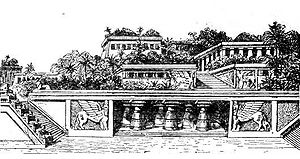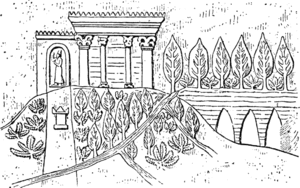Hanging Gardens of Babylon
The Hanging Gardens of Babylon,[1] and the walls of Babylon (near present-day Al Hillah in Iraq) were one of the Seven Wonders of the World. They were built by Nebuchadnezzar II around 600 BC. He is said to have built the gardens to please his wife, Amytis of Media. She wanted to see the trees and plants of her homeland. The hanging gardens were destroyed in an earthquake after the 1st century BC.


Existence
changeSome people do not believe the Hanging Gardens were real. In ancient writings the Hanging Gardens of Babylon were first described by Berossus, a Chaldean priest. He lived in the late 4th century B.C. Greek historians later wrote more about them.[2]
Recent archaeological digs of the palace in Iraq have uncovered evidence of a building with vaults and a well nearby. However, the place of the palace complex is different from where Greek historians said they were, which was on the banks of the Euphrates River.[2] Also recently, there have been digs on the banks of the Euphrates River of some large 25 meter-thick walls.[2]
References
changeOther websites
change- Seven Wonders of the World: The Hanging Gardens of Babylon Archived 2005-09-05 at the Wayback Machine
- Technology and Culture. 44, 1, 2003 Dalley, Stephanie. Oleson, John Peter. "Sennacherib, Archimedes, and the water screw: the context of invention in the ancient world"